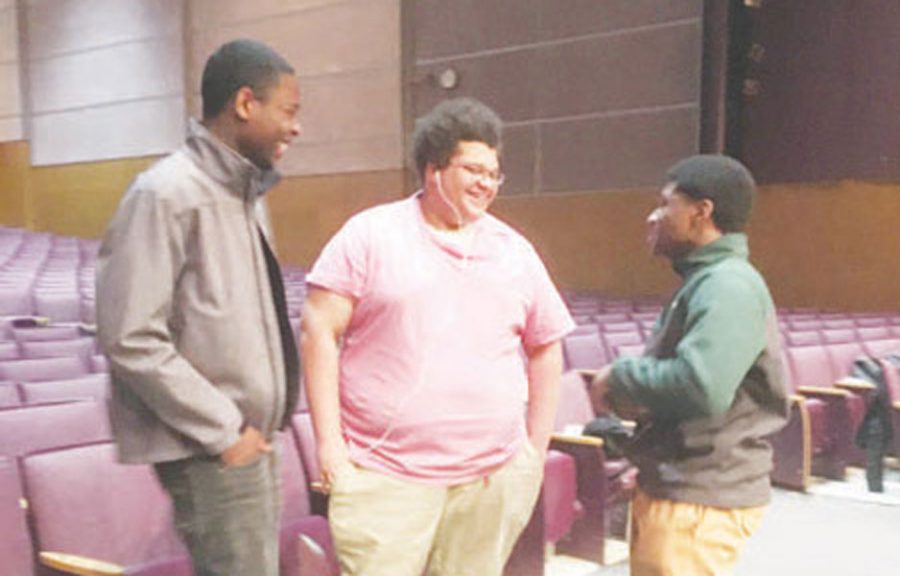PTG’s production of ‘In the Heights’ attracts controversy
From right, Treyvon Foster (junior), Shane Collins (junior), and Avery Cosey (senior) discuss plans for “In The Heights.”
When Pioneer Theater Guild first announced it was planning a production of “In The Heights,” with music by Lin Manuel Miranda of “Hamilton” fame, many people were shocked at the choice. “In The Heights” takes place in the primarily Latinx neighborhood of Washington Heights in New York City and follows many characters and their struggles with being Latinx in America. While some Theater Guild members say the show is an important step in making Theater Guild more diverse, others argue that it will come off as tone deaf and offensive.
Part of the reason Pioneer Theater Guild chose to do this show was to attempt to become more diverse, according to organizers. “It will be the first musical we’ve done that is written by a non-white male. It offers a different perspective and it offers a great opportunity to include people of all backgrounds. There’s a place for everybody in this show,” says producer Quinn Strassel.
However, there has been controversy about whether or not doing this show will actually help make PTG a more diverse and inclusive space. When the casting list came out many people were disappointed to see very few Latinx actors in the show.
Pioneer Junior Clara Nunez- Regueiro, a PTG pit member, does not support the choice to do the show and is concerned that certain Latinx cultural themes will be misrepresented since there are not many Latinx actors in PTG. “Some characters in the show have heavy Spanish accents while speaking English. When someone who is not Latinx is imitating this accent, which Latinx students’ own families and friends have, it can feel like a mockery,” she said.
Nunez-Regueiro also says that the show is so deeply connected to many Latin American cultures that it makes no sense for non- Latinx actors to pretend to be a part of that culture. “This entire show is about struggles that Latin American immigrants/first generation people face – their daily lives as outliers, how their Latin American cultures interact with their USA cultures.”
Pioneer senior Sanomi Croos- Dabrera is playing one of the leads, Nina. When she heard about the decision to do the show, she said she had mixed feelings about what it meant for PTG. “As a non-Latinx person, I cannot speak on behalf of the Latinx community. Being given the opportunity to tell the stories of immigrants is something that really resonates with me as a first generation kid,” says Croos- Dabrera, noting that “the message and themes of ‘In The Heights’ are very important.”
Croos-Dabrera was disappointed as well when the casting list came out, but believes that some progress is being made. “I was really disappointed that there weren’t more Latinx students cast in leads. On the flip side, I think PTG is taking a good step towards diversity. The cast has roughly a 70 percent majority of people of color in the show, whereas last year we only had a handful of people of color acting in the show at all.”
When “In The Heights” was chosen, Strassel knew that many people would have issue with the casting. However, he believes that is what happens when big changes are made.“ I think it’s scary whenever you do something different. But positive change doesn’t happen unless you’re willing to do things that make us uncomfortable,” he said.
Strassel also believes that without making big controversial choices, PTG will never become a more diverse place. “It’s hard to make PTG more diverse unless you make active choices that allow for more people to feel invited,” says Strassel.
However, some say that this step will not end up making PTG feel more diverse. “We definitely need to have more people of color in the spotlight, [but] it’s not okay to try on a culture that isn’t yours and make a misrepresented performance out of it. People of color are not interchangeable with one another,” says Nunez- Regueiro.
Croos-Dabrera said that while there are many flaws with this rollout, it’s an important first step in making PTG more diverse. “Hopefully next year they will pick a show that promotes diversity without misrepresentation,” says Croos-Dabrera. “We need to find a way to tell stories without misrepresentation. The program is still learning, it has the potential to be a place that welcomes all, but it has a ways to go. I hope that this show will inspire more people of color to join the show instead of discouraging them.”


